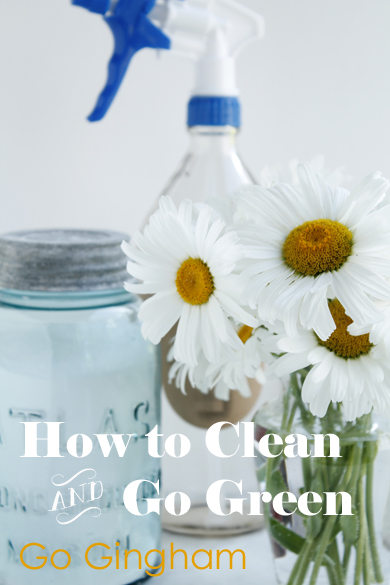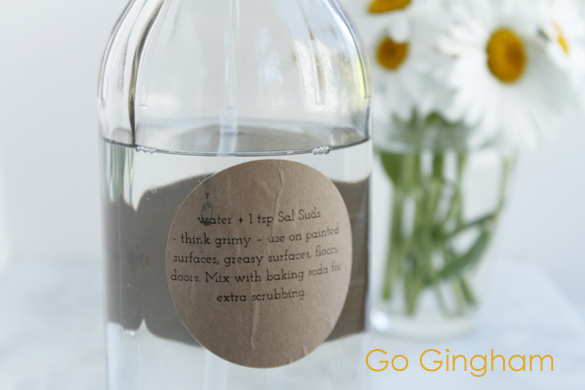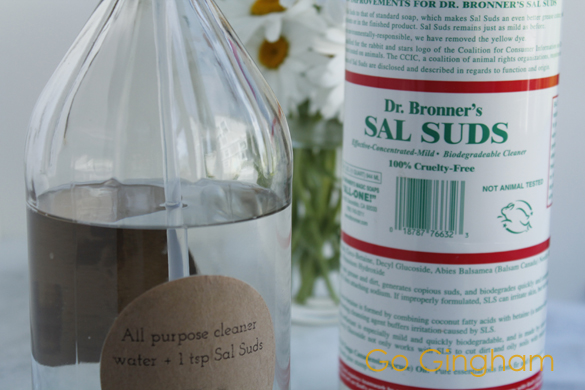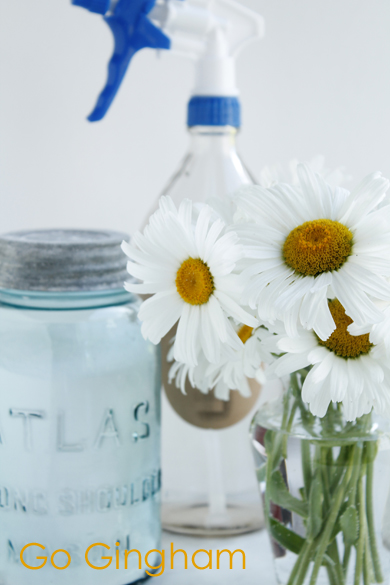
Because we’ve decided to allow fewer chemicals into our home, it’s changed the way we do things. At first it was a hassle – having a new routine always is, isn’t it? Now, it’s how we live.
We have been completely tricked into thinking the ‘green’ and ‘natural’ and ‘household’ and ‘anti-bacterial’ cleaners that are being sold in every grocery store are what they say they are – necessary for us to buy for our homes, green, natural and better for us. But, are they really? Not at all.
Remember when I told you I was revamping all of the cleaning supplies we use? Well, after much mixing, testing and using – here’s the bottom line: Our house is clean, our health has improved (more on that later), we’ve saved a ton of money by skipping the cleaning aisle at the store, and we’re not continually buying plastic spray bottles filled with mostly water and harmful chemicals.
My resource for all of this? Environmental Working Group (EWG). Before I buy any products to bring into our home, I check there. Here’s why:
The Environmental Working Group is an online, independent resource for consumer health products. And it has lists of what’s in our cleaning supplies and laundry detergents. They also share which ingredients have been banned in other countries, but not in the U.S. They rate the products based on their ingredients. I think it’s important to note that the EWG does not endorse any products or brands.
“EWG’s Guide to Healthy Cleaning is an online safety guide for household cleaning products, launched in 2012 to help people find safer products that fully disclose their ingredients and contain fewer ingredients that are hazardous or that haven’t been thoroughly tested. The database combines product ingredient lists gleaned from product labels, company websites and worker safety documents with information in more than 16 standard toxicity databases and extensive searches of peer-reviewed scientific literature. The database provides easy-to-navigate safety ratings for more than 2,000 cleaning products.”
These are the questions EWG used to rate cleaning and household products:
- Does the product contain hazardous substances?
- Do we know about all the ingredients?
- Do other factors come into play?
- How does this product rate overall?
There are only two spray solutions we use at home – one is for cutting grease and the other for shiny surfaces. Here’s the all purpose grease cutter and next I’ll share the shiny.
Green and Clean All Purpose Household Cleaner
First, let’s think grimy. You know the places that get grimy – kitchens, bathrooms, greasy spots, laundry stains, and all painted surfaces.

Here’s my go to formula:
- 1 empty bottle – empty vinegar glass bottle works – 32 ounce bottle/1 quart/ 946 milliliter
- 1 teaspoon of Dr. Bronner Sal Suds (Here’s EWG’s review of the product.)

Directions
- Fill the empty bottle with water almost to the top.
- Add 1-teaspoon of Dr. Bronner’s Sal Suds.
- Add sprayer and shake – a little.
- Done.
Easy, isn’t it? This is all I use to clean up. It’s especially helpful after dinner – granite counters, butcher block wood island, stainless steel sink, stainless steel appliances, and extra dirty dishes.
Using it every day
Since we cook at home every day – sometimes it feels like all day – the kitchen counters are caked with food. By the end of the day and when dinner dishes are getting done, I like to use this spray. Here’s a good routine: spray the kitchen counters, pour a glass of wine, have a couple of sips, and then wipe it down. Sometimes I need a razor blade on the granite – yes, I’m careful! – but doesn’t always get cleaned up after cooking. At night, it gets a thorough cleaning. I like to wake up to a clean kitchen.

Need extra scrubbing power?
Whenever this cleaner needs a boost, I sprinkle on the baking soda. Chemistry class here – baking soda is a base and works well with the Dr. Bronner’s Sal Suds. Spray it and then sprinkle with baking soda. (Make this baking soda shaker complete with vintage glass yourself!) Let it sit for a few minutes and scrub. Wipe up. Sometimes I let this pasty mixture sit overnight in our kitchen sink. It also works well for taking sticky labels off glass bottles. Any cloudy leftover on the surface can be wiped with the shiny spray that I’m sharing next (hint-hint – it’s half water half vinegar in a spray bottle.)
Ceramic cook-top stoves
Spray generously with water and Sal Suds mixture and sprinkle with Bon Ami. (Here’s EWG’s review of this product.) Let it sit for several minutes and then scrub with a sponge in circles. Use a razor blade for hard to remove spots. It works just like the creme ceramic/glass top stove cleaner but no chemicals. Love it!
Kitchen sink, bathroom sink, bathtub
The toilet is sorta clean but my kids are in charge of that and just between the two of us – it could be cleaner. For cleaning the toilet bowl, we use the laundry detergent booster that’s listed here. When using cleaners that aren’t harsh and full of chemicals, cleaning regularly and not letting things like toilets get too dirty is helpful.
Painted wood surfaces
Our 1914 craftsman bungalow has a lot of woodwork. It’s all painted and this is what we use to wipe all the wood trim. Dampen a cloth and spray it a few times. Wipe away. The dirty, wet cloth can go in with the laundry now. Since the harsh chemicals (aka hazardous waste) are gone, I don’t mind washing cleaning rags with clothing.
Got laundry stains?
I use this for pre-treating stains, too. The biggest tip is this: keep the cloth/garment that’s stained wet with water. If you put cold water on a stain and then spray it with this solution – adding a sprinkle of baking soda if you’d like – it’s the best stain remover I’ve found. If your cloth/garment dries, it’s much harder to remove the stain. Don’t put garments into the dryer until the stains are gone. Hot dryers set the stain. (Want to use your dryer less? Check here.)
The bottom line: My house is clean. The bathtub is clean. The kitchen is clean. The laundry is clean. The chemicals are gone.

Sal Suds is not always easy to find. People’s Food Co-Op carries it in Portland. Dr. Bronner’s sells it online. Our family of four goes through about 2+ bottles (32 ounces) in a year. It lasts a long time – and we use it on our laundry, too. (Read laundry detergents to use and why here.) It works well in an automatic dishwasher, too. Use about 1 teaspoon. (Read my sort-of-homemade dishwasher detergent recipe here.)
This isn’t going to work like spraying 409 or Fantastik on your surfaces. It’s actually ‘green’ and ‘natural’ and not just making the claim that it’s ‘natural’ or ‘green’ or ‘simple green’ – it honestly is.

It’s an adjustment to get used to at first. Spray and walk away. Let the Sal Suds spray work while you do something else for a few minutes. We want everything to work now and that’s not how this cleaner works. In the end, you’ll be glad you made the switch. Your pocket book will be glad, too. The air inside your home will be healthier and there’s less waste. Wins all around!
Next up, shiny surfaces.
Are you trying to reduce the number of chemicals that come into your home? What’s working for you?
Go Gingham related links:
Need an automatic dishwasher detergent recipe? You’ll find that here.
How about a natural rinse aid for the dishwasher? Yes, you have it in your pantry right now!
Make your own hand-soap with these easy directions – you’ll never buy it again.
Easy to sew reusable mop cover – make it using an old t-shirt!
More related links:
Here’s EWG’s list of all purpose cleaners that all were graded ‘A’ in their system. While I considered using several of the sprays in this list, I quickly abandoned the idea. After looking at their prices in the store and wanting to stop buying additional containers, I felt there had to be another way. Once I tried the Sal Suds in the bottle mixed with water, the light bulb went on. It costs so little for an entire spray bottle full and there’s no waste. If you can make your own for pennies, why buy cleaning supplies that are mostly water and harmful chemicals?
Disclosure: I have no material connection to the brands, products, organizations or services that I have mentioned.
I am a vinegar and water in a spray bottle gal. I use Bon Ami for the toilets and kitchen sink. Baking soda is my other go to. I used to make my own laundry soap but recently changed to Seventh Generation and OXO brite.
LikeLike
Shannon,
Very nicely done! I’ll have to take a look at the OXO brite….
My kids both use the Seventh Generation for their laundry and like it. I use their non-chlorine bleach, too.
Thanks for sharing, Shannon!
LikeLike
I don’t suppose you have a trick for getting out oil stains on clothes? I tried Zout because it was recommended to me by a friend…but it doesn’t always work and I’d love to have an all-natural solution instead!
LikeLike
Hi Heather!
If you can put baking soda on oil that should help absorb it and then spray with this all purpose cleaner. Don’t dry it in the drier until the stain/spot is gone. Drying (the heat) will set the stain.
Good luck!
ps can you take the Zout back to the store???
LikeLike